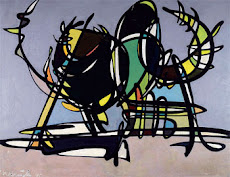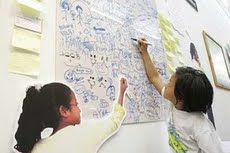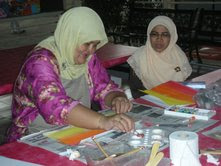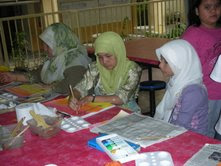On the side of truth and justice
What is the biggest difference in the art scene today compared to the past?
I have seen the art scene progress from Merdeka to now. I witnessed the British flag come down and Malaysian flag go up. In terms of art, you could say I am a child of Merdeka.
A year after Merdeka, Tunku Abdul Rahman set up the National Art Gallery to preserve Malaysian art. There were groups of people in power, mainly government servants, who supported the arts and wanted to see the art scene grow. The support given to nurture the arts was healthy and fantastic. Artists like me had more freedom and were not hampered by tradition.
Art was seen as an expression of society.
The government encouraged and supported artists to take part in international exhibitions.
Malaysian art was travelling all over the world. International audiences and critics were impressed with our work and praised it. I was only in my 30s when I got such exposure and responsibilities.
But slowly the exposure of Malaysian art in the international art scene declined.
Why do you think this happened?
The focus was on the economy, culture and politics. The emphasis was more on science and technology. There was a period when the government was even suspicious of artists.
I believe we should have continued our effort to expose our art outside Malaysia. We should have taken part in more international exhibitions.
Are you saying the government doesn’t support the art scene any more?
The government is still giving support. But it is not on a big scale. There are more artists now and the artists are more successful economically. They can paint and still survive. In the old days, artists like me could not make a living as an artist. A lot of us had to become art teachers. Now, there are art patrons such as banks, various organisations and individuals who are willing to buy art works. The art scene is healthier.
If we had continued to actively promote our art outside Malaysia, by now our art would have gotten international recognition. Right now, there is no vision of bringing Malaysian art outside Malaysia.
Why do you think the emphasis is more on science and technology?
It is not for me to say why the government decided to do this but I would like to see an equal emphasis on the arts. It is still not too late to get international recognition. We have the artists and the work to impress international audiences and critics.
Are you sad, bitter and de-motivated that the government has given less emphasis to the arts?
I am not. If I was sad, bitter and de-motivated, I would not have carried on. If you look at my body of work, you will know I have been producing art works despite the condition we were in. I believe everything that happens is God’s will. We must make the best of any situation. We cannot protest so much. We cannot be mourning always. Besides, I have never created art just to get fame and fortune. I create art because I need to express myself as a creative individual.
Is the government doing enough?
It is never enough no matter how much they do. I will always wish for more. (We laugh).
Are artists respected in Malaysia?
I do not know about respect. But I think there is recognition. People are willing to pay RM200,000 for a painting. It goes to show there is recognition. When I became an artist, it was never about the money. If I thought about the money I would have done something else. In my early days, I could not survive as an artist. I became an art teacher so I could paint in the afternoon.
Some people have this impression the art in this country caters to the elite. Do you agree?
It has become such a cliché. I never paint for the elite. I paint because there is a compulsion in me to express myself as a creative person. Sometimes I give a free talk on art because I want to give back to society.
There are organisations who would love to buy some of my works at any price. But I am not willing to part with those works because they involve the history of this country and it should belong to certain organisations where everyone has a chance to see them. If I had painted for money, I would have parted with those works a long time ago. There might be some artists who create art for the elite only. But that is not my concern.
What is your advice to young painters?
You must be honest and sincere in your work. If you paint for money, you might be successful for a while. You create art because you are compelled to … it is part of your existence.
What is the constant message in your work?
There is an aspect of truth and reality in my work. My work reflects my relationship with the world I live in ... my relationship with my country ... my relationship with my environment … and the political situation. I am not envious of people in power. But I am not fond of pretentious politicians. I have addressed unpleasant issues on canvas such as Palestine, Reformasi and the May 13 riots.
Has your work offended anyone?
I held an art exhibition where I had painted Mahathir (Tun Dr Mahathir Mohamad who was the prime minister then) and Musa (Tun Musa Hitam, the former deputy prime minister) on one canvas. My work showed the 2M (Mahathir and Musa) factor in political scenario. Obviously, Mahathir was not happy with the piece. But I didn’t paint for him. As an artist, I study the situation around me and put it on canvas.
Much later I had another exhibition that showed the country’s progress over 50 years. He (Mahathir) was smiling moving from one canvas to another. He stopped smiling when he came to one work that reflected the Reformasi period (Anwar Ibrahim being sacked as deputy prime minister). This time around, he was not so angry. My wife and I even bumped into him at Starbucks after the exhibition. My wife wanted to take a picture with him. He obliged. He even took a picture with me and jokingly said he could use the picture against me and show that ‘I am on his side.’ (He smiles). I didn’t create those pieces to offend him. I paint to reflect the situation around me.
Have you come to a stage where people are afraid to criticise your work?
I do not expect people to praise my work all the time. But if you criticise my work, you must have valid reasons to support your views. You must have some knowledge of art before criticising my work.
But are you ready to face bad reviews?
So far nobody has said anything bad about my work. Are you going to be the first to give me a bad review? I am ready to face any review. But it is must be constructive criticism.
There is a belief that Islam forbids Muslim artists from drawing figures and portraits. What is your stand?
It is not forbidden. If you look at Persian, Turkish and Moghul paintings, there are figure drawings and portraits. As long as you do not create an image with the aim of worshipping it, you are not going against Islamic teaching.
What is the greatest misconception people have about you?
People believe that I belong to a certain political party. But I do not. I stand on the side of truth and justice.
Why do you think people jump to this conclusion? Is it because you created the logo for Parti Keadilan?
I created a few paintings about Anwar and the Reformasi period and I would not deny that I created the logo for Keadilan. I called it Adil (Justice). But they modified it and called it Keadilan.
So people jump to the conclusion I belong to the opposition camp. But that is not the case.
I have also painted on other issues. I paint what I see. I have done logos for other organisations.
PAS asked me to join them. But I refused. I do not want to belong to any political party. Like I said earlier, I want to be on the side of truth and justice.
Were you disappointed when the party changed your logo from Adil to Keadilan?
Why should I be? It is their organisation. They have the right to modify my logo. They have every right to do what is best for their organisation.
What is your view on 1Malaysia?
There has always been 1Malaysia and there will always be 1Malaysia. Since independence, we (all of the different races) have always worked together peacefully in every aspect. Of course there will be hiccups and we will not always be perfect. It is the same with any other country, including the United States and United Kingdom. The idea of us working together should not be a deliberate effort. It should be a natural process.
Do you have any dream as an artist you want to accomplish now?
Yes. I have a few projects in mind. These art works are large pieces … huge sculptures and art designs. One of my projects is to show the Malay culture from the past to the present. It will be like mini-museums where you see the influences that shape the Malay community. People tell me that these dreams are difficult to materialise because of the size. I will not stop trying to make this dream come true. I believe as long as there is hope, there is a chance that these dreams will come true, God-willing.
Do you remember what inspired you to become an artist?
I was 10 or 11 when I saw some artists in Johor Baru (his hometown) painting in water colour and I thought these works were beautiful. I was inspired to create similar works.
Who are the artists you admire?
Titian Bohicelli (Italy), Picasso (Spain), Braque (France), Matisse (France), Truner (Britain), Monet (France) and many more. They were innovators and ground breakers who gave shape and form to the manifestation of human spirit.
If you were not an artist, what would you have become?
Most probably a writer. In school, I actively took part in writing competitions and won a few. I have written several articles and a few books on the arts. My memoir Kunang-Kunang: Kenang-Kenangan Syed Ahmad Jamal was published in 1997. It was in Malay. I have plans to write a memoir in English.
Wednesday, November 11, 2009
Subscribe to:
Posts (Atom)






.jpg)

